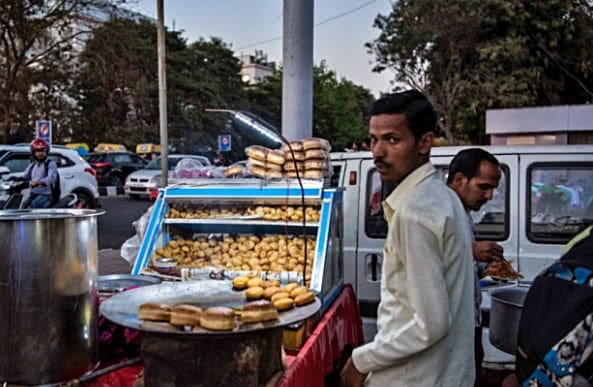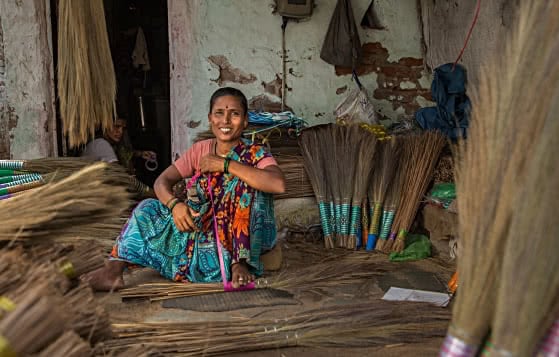Delhi Diary offers reflections, insights and notes from the field by the Focal City Delhi (FCD) team in their ongoing work with informal workers. We capture these on a regular basis to provide a dynamic picture of how informal workers in Delhi consistently struggle, resist and innovate against great odds. The views expressed here represent those of the FCD team.
Town Vending Committees—An Opportunity for Worker Participation
By Avi Singh Majithia | May 15, 2019
There are close to 300,000 street vendors in Delhi—yet the Municipal Corporation of Delhi officially counts about 125,000 “legal” vendors. According to the Self-Employed Women’s Association (SEWA) (2019), around 30% are women (SEWA, 2019). Street vendors work in public space, and management of public space is one of the most pressing issues in India today.
With competing claims on public space, its governance is an issue of extreme importance for street vendors.
The Street Vendors (Protection of Livelihood and Regulation of Street Vending) Act (2014) is a step in the right direction to bring to light the right of vendors to public spaces. The Act protects the rights of street vendors and regulates vending activities. It clearly specifies the roles and responsibilities of both vendors and municipal corporations and sets an important precedent for inclusive approaches to street vending.
The institutionalized form of the law is the Town-vending committee (TVC). According to the Act, a TVC must:
- conduct a survey of all existing street vendors
- issue identity cards and certificates for vending
- ensure that all existing street vendors are accommodated in vending zones, and
- ensure that no street vendor is evicted until the above-mentioned survey is completed.
Chaired by the Municipal Commissioner or Chief Executive Officer of the municipality, the TVC is intended to be a comprehensive committee of all stakeholders—government officials, municipal officers, street vendors, bankers, traffic police, NGOs, RWAs etc.
Most importantly: the Act stipulates that street vendors representatives must constitute 40 per cent of the TVC members. An additional 10 per cent of TVC members must be from non-governmental organizations. Thus, 50 per cent of the TVC are from civil society. While the government, market and residential representatives are nominated, the street vendors (who make up 40 per cent of the TVC) are democratically elected to the TVCs.
Challenges
However, since their constitution, these TVCs have been dogged with challenges.
At WIEGO Focal City Delhi, we recently met with street vendor representatives in the TVCs of Delhi to understand their challenges.
Continuing eviction remains a major challenge. A recent analysis of news about street vendors around the world revealed that the number of evictions is growing around the world. This is a troubling trend, and the story in Delhi is no different. During the process of constituting provisional TVCs (to update vendor rolls in the city), evictions have continued at an alarming rate leading to many vendor protests across the city.
A second issue has also emerged. There is a lack of will on the part of the municipal players to make the TVCs effective. During the consultation it was revealed that in the 6 months of their operation, most TVCs only met twice, with no major decisions being taken. With the ongoing general election, the TVCs seem to be in détente, waiting for the next phase of their operation, with the long-awaited scheme being released recently.
The biggest challenge, however, remains that of the barriers that vendors have historically faced. The TVCs, despite an equitable structure that leans in favour of the vendors, operate very differently. Many reported that the government representatives do not wish to engage with them in discussion, considering them unaware of the technical implications of plans and schemes. Thus, vendors are often marginalised. In most TVCs, the meetings are largely conducted in English (leaving out the majority of non-English speaking vendors). Any minutes, if circulated, are also in English and vendors often are unaware of what they are agreeing to implement.
The Street Vendors Act (2014) is heralded as a unique legislation which works to positively impact the lives and livelihoods of street vendors. However, the passing of a law is by no means the end of the road. Implementation remains a challenge.
Five years on, implementation is only just beginning and is incomplete and insufficient. The latest consultation with TVC members showed that while institutional systems are being put in place, their inefficiency is forcing vendors to go back to the drawing board.
In the last 8 months since the constitution of TVCs in Delhi, there has been a fervour in the vendors’ movement. From negotiating within the TVC to recognizing the need for capacity building, vendors are once again adapting to the changing needs of the dialogue process in order to better negotiate with the authorities.
Definitions Matter: Who is a Street Vendor and What is a Street?
By Avi Singh Majithia | April 8, 2019

We see them every day, on almost every city street in India—so asking ‘What is a street vendor?’ might seem strange. Yet how we define and understand street vendors, their work and even the notion of ‘the street’ itself is at the heart of the latest issues that confound those who make a living by selling in public space.
A recent report highlighted the decision of the Punjab and Haryana High Court to review the definition of a street vendor as given by the Street Vendors (Protection of Livelihood and Regulation of Vending) Act, 2014. Citing issues of street congestion, pedestrian safety and general cleanliness, the Court suggests that the existing definition is too broad and should be narrowed. The report brought back many of the long-standing tensions surrounding how and by whom street vending should be defined—a debate with direct implications for street vendors’ ability to earn a livelihood in Indian cities. Street vendors in India are estimated to account for 14 per cent of all informal urban employment and 4 per cent of the urban workforce across India. Street vending is not only a critical source of self-employment for the poor in cities and towns but also a means to provide affordable goods and services to much of the urban population, in convenient locations.
Street vendors are integral to city life in India, and their contributions could be enhanced towards the creation of more equitable and environmentally sustainable cities. However, in order to promote this potential, the public and policymakers need to understand, recognise and value their diversity and their contributions.
There are several different kinds of vendors in the city of Delhi, but three basic categories can be highlighted: those who buy goods from wholesalers and sell them at a margin (fresh fruits and vegetables, for example); those who make or manufacture goods for sale (cooked food vendors); and those who provide or perform services in public spaces (such as barbers).

Within these categories, vendors can further be categorised by gender, the type of good they sell, whether they work alone, with family or employ others, and by the location from which they work.
Street vendors may vend in a daily or weekly recognised market or by the road in ‘natural’ markets. Some other special types of markets are also evident in Delhi--the heritage book market of Darya Ganj, and all women Mahila market on the velodrome road, for example.
Street vendors are a diverse group of workers not bound by geography or even mobility. They can vend from fixed stalls, or from pavements, or even be mobile. The multiplicity of types of vendors necessitates the broader view of street vending which is incorporated in the Street Vendors (Protection of Livelihood and Regulation of Vending) Act. If a more limited definition were adopted, as the Punjab and Haryana High Court seem to suggest is needed, it would result in large numbers of vendors losing their protections and rights.
As it is, despite the presence of the Street Vendors Act--an empowering law which calls for protecting and regulating all vendors--many street vendors remain vulnerable to harassment, eviction and stigmatisation in Indian cities. Despite their contribution to the urban economy, vendors are often considered ‘antisocial, anti-developmental, dirty, unaesthetic and unhygienic’. Competing uses for public space and political pressures often result in the exclusion of the most vulnerable street vendors, sometimes in direct violation of the Act. The fact that street vendors (and informal workers at large) are not included as stakeholders in the city’s planning processes compounds the problem.
As part of WIEGO’s Public Space For All Project, a recent discussion paper on public space argues that the struggle over public space should not be a zero sum game. Regulation of public space should offer possibilities for diverse uses of public space, which are vibrant and inclusive. Such a vision would benefit both vendors and local authorities in India. However, for this vision to become a reality, street vendors’ hard fought gains under the Act must be protected, and the Act itself must be implemented, together with and for street vendors across Indian cities.
